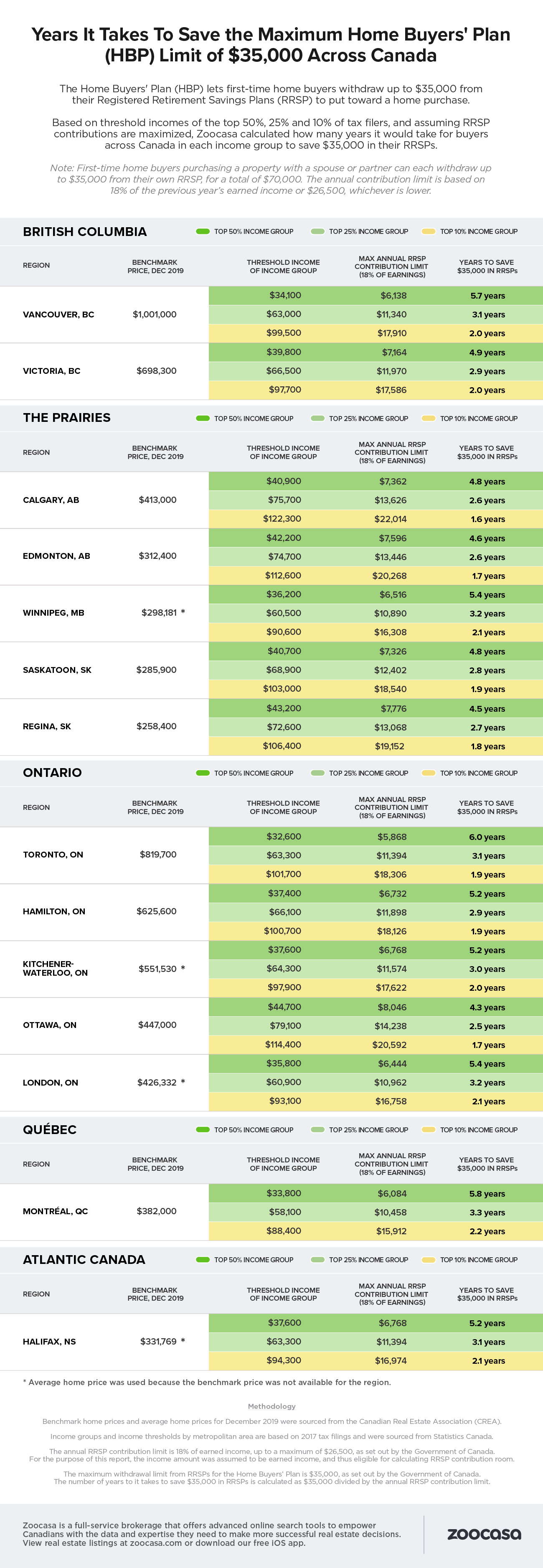By: Zoocasa
The Home Buyer’s Plan, or HBP, was implemented by the federal government in 1992 to help first-time buyers purchase their first residence by allowing them to borrow up to $35,000 from their RRSP savings.
But how effective is the HBP, really? Does it actually help buyers get a foothold in the market? What are its advantages and drawbacks? Let’s find out.
Do Enough Canadians Use Their RRSPs?
One main criticism of the plan is that the
While 35% of all Canadians contribute to RRSPs, according to Statistics Canada, they are most used by households with a major income earner bringing in $80,000 – $99,999 and who are between the ages of 35 – 54.
Stats Can
Does the HBP Limit Reflect Today’s Home Prices?
Another potential drawback of the HBP is that it doesn’t reflect current home prices in all Canadian housing markets; prices are extremely high in most urban centres outside of the Prairies and Maritimes. The maximum $35,000 that can be withdrawn is rarely large enough for a 20% down payment, which is the minimum amount buyers need to pay in order to avoid getting CMHC mortgage default insurance.
In Vancouver, $35,000 would equal just 3.5% down for a benchmark-priced home, and in Toronto, just 4.3%. Even in smaller urban centres in Ontario, $35,000 doesn’t go far — it would only equal 6.3% of average Waterloo homes for sale and 7.8% of the average home listed on the Ottawa MLS.
You’d have to go out to Halifax and the Prairies for $35,000 to reach over 10% down on a benchmark-priced home.
One way to offset this is to buy a home with a partner who is also able to take out the maximum HBP for a total of $70,000.
You Have to Pay Your RRSP Back
The third drawback is that the HBP only allows you to borrow the funds from your RRSP — you’re still on the hook for repaying yourself a certain amount every year for the next 15 years. While this may be good for your retirement plans, it means you have to save up for it throughout the year on top of your new housing expenses.
So far we’ve gone through the drawbacks of the HBP — but what are the advantages?
Tax is the Main Benefit of the HBP
Contributing to your RRSP lowers your taxable income and generally triggers a larger tax refund. If home buyers start contributing to their RRSP and save up this tax refund toward
In general, the HBP is most effective for Canadians who earn a high income and live in areas with low housing costs. That way they are able to contribute to their RRSP to lower their taxable income and increase savings, and the $35,000 they withdraw will go further in purchasing a home.
For lower-income Canadians (under $50,000 or so) it doesn’t make much sense to contribute to an RRSP now since they’ll hopefully be in a higher tax bracket at retirement. For them, saving for a down payment in a TFSA would offer the same tax-shelter benefits as an RRSP, plus far more flexibility.
Check out the infographic to learn in which city your HBP plan will go the furthest

Zoocasa is a full-service brokerage that offers advanced online search tools to empower Canadians with the data and expertise they need to make more successful real estate decisions. View real estate listings at zoocasa.com or download our free iOS app.
